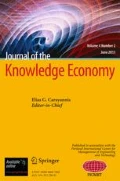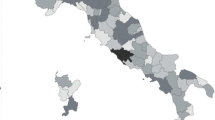Abstract
In a globalized economy and becoming more knowledge-based, two apparently contradictory phenomena are shaping the organization and location of many mature economic activities: a general tendency of firms to agglomerate geographically while traditional clusters (and notably industrial districts) are facing a period of crisis in their identity, structure, and cohesion. Since the turn of the new century, regulatory changes, intensified global competition, rapid changes in technology and markets, and increasing complexity and uncertainty in the business environment, have created a more dynamic and globalized market conditions for the European firms of mature industrial sectors, like textile and clothing (T&C) industry. As a result of these changes and of the firms’ responses, the future of this industry and of the regions where it is located has been put into question. The aim of this research is to determine the territorial dynamics of startups in the textile and clothing industry in Spain. For this research, we have adopted a historical perspective focused on analysis of the intersection of the geographical locations of startups in Spain (the industrial district effect) and the main types of activities performed by new-venture firms (the subsector effect). Our results have important implications for the theory and practice in the textile and clothing industry: the need to distinguish the location of a firm when both analyzing its performance and formulating and implementing public policies.

Similar content being viewed by others
References
Becattini, G. (2004). Industrial districts: a new approach to industrial change. Cheltenham: Edward Elgar.
Buckley, P. J., & Ghauri, P. N. (2004). Globalisation, economic geography and the strategy of multinational enterprises. Journal of International Business Studies, 35(2), 81–98.
Buxey, G. (2005). Globalisation and manufactoring strategy in the TCF industry. International Journal of Operations & Production Management, 25(2), 100–113.
Costa, M. T., & Viladecans, E. (1999). The district effect and the competitiveness of manufactoring companies in local productive systems. Urban Studies, 36(12), 2085–2098.
Coucke, K., & Sleuwaegen, L. (2008). Offshoring as a survival strategy: evidence from manufacturing firms in Belgium. Journal of International Business Studies, 39(8), 1261–1277.
Cromley, R. G., & Hanink, D. M. (2012). Focal location quotients: specification and applications. Geographical Analysis, 44(4), 398–410.
De Propis, L., & Lazzerretti, L. (2009). Measuring the decline of a marshallian industrial district: the Birmingham Jewellery Quarter. Regional Studies, 43(9), 1135–1154.
Dei Ottai, G. (2002). Social concertation and local development: the case of industrial district. European Planning Studies, 10(4), 449–66.
Delgado, M., Porter, M. E., & Stern, S. (2010). Clusters and entrepreneurship. Journal of Economic Geography, 10(3), 495–518.
DeMartino, R., McHardy Reid, D., & Zygliodopoulos, S. C. (2006). Balancing localization and globalization: exploring the impact of firm internationalization on a regional cluster’. Entrepreneurship and Regional Development, 18, 1–24.
DG Enterprise & Industry (2010). EU manufacturing industry: what are the challenges and opportunities for the coming years? Retrieved from http://ec.europa.eu/enterprise/policies/industrial-competitiveness/economic-crisis/files/eu_manufacturing_challenges_and_opportunities_en.pdf
Drucker, J. (2011). Regional industrial structure concentration in the United States: trends and implications. Economic Geography, 87(4), 421–452.
Dyer, B., & Ha-Brookhire, J. E. (2008). Apparel import intermediaries’ secrets to success: redefining success in a hyperdinamic environment. Journal of Fashion Marketing and Management, 26(1), 66–90.
Eurostat (2009). Various statistical databases from Eurostat. Online, available: http://eurostat.ec.europa.eu. Accessed 6 December 2009.
Feldman, M. P., Francis, J., & Becovitz, J. (2005). Creating a cluster while building a firm. Entrepreneurs and the formation of industrial clusters. Regional Studies, 39(2), 129–141.
Giuli, M. (1997). The competitiveness of the European textile industry. Research Papers in International Business, 2, 80–97.
Glaeser, E. L., & Kerr, W. R. (2009). Local industrial conditions and entrepreneurship. How much of the spatial distribution can we explain? Journal of Economics and Management Strategy, 18, 623–663.
Ha-Brookshire, J. E., & Dyer, B. (2008). Apparel import intermediaries. Clothing and Textiles Research Journal, 26(1), 66–90.
Ha-Brookshire, J. E., & Lee, Y. (2010). Korean apparel manufacturing industry: exploration from the industry life cycle perspective. Clothing and Textiles Research Journal, 28(4), 279–294.
Hair, J. F., Anderson, R. E., Tatham, R. L., & Black, W. C. (2000). Análisis Multivariante. Madrid: Prentice Hall.
Hervás-Oliver, J. L., & Albors-Garrigós, J. (2008). Local knowledge and domains and the role of MNE affiliates in bridging and complementing a cluster’s knowledge. Entrepreneurship & Regional Development, 20(3), 581–598.
Holmes, P., Hunt, A., & Stone, I. (2010). An analysis of new firm survival using a hazard function. Applied Economics, 42(2), 185–195.
INE (2004). Instituto Nacional de Estadística. (2001): Censos de Población y Vivienda. Retrieved from www.ine.es/censo/es/inicio.jsp. Accessed 31/08/2009.
Jódar, P., Coduras, A., Jarque, S., Mendoza, R., & Rodríguez, C. (1997). El sector textil: una aproximación territorial. Terrassa: A.C.T.E.
Jones, R. M., & Hayes, S. G. (2004). The UK clothing industry. extinction or evolution? Journal of Fashion Marketing and Management, 8(3), 262–278.
Martin, R., & Sunley, P. (2011). Conceptualizing cluster evolution: beyond the life cycle model? Regional Studies, 45(10), 1299–1318.
Menzel, M. P., & Fornahl, D. (2010). Cluster life cycles-dmensions and rationales of cluster evolution. Industrial and Corporate Change, 19(1), 205–238.
Molina-Morales, F. X., & Martínez-Martínez, M. T. (2004). How much difference is there between industrial district firms? A net value creation approach. Research Studies, 33, 473–86.
Molina-Morales, F. X., Capó-Vicedo, J., Tomás-Miquel, J. V., & Expósito-Langa, M. (2012). Análisis de las redes de negocio y de conocimiento en un distrito industrial. Una aplicación al distrito industrial textil valenciano. Cuadernos de Dirección de Empresas (CEDE), 15, 94–102.
Obadic, A. (2013). Specificities of EU cluster policies. Journal of Enterprising Communities: People and Places in the Global Economy, 7(1), 23–35.
O’Donoghue, D., & Gleave, B. (2004). A note on methods for measuring industrial agglomeration. Regional Studies, 38(4), 419–427.
Parr, J. B. (2002). Agglomeration economies: ambiguities and confusions. Environment and Planning, 34, 717–731.
Pe’er, A., & Keil, T. (2013). Are all startups affected similarly by clusters? Agglomeration, competition, firm heterogeneity, and survival. Journal of Business Venturing, 28(3), 354–372.
Pickles, J., & Smith, A. (2011). Delocalization and persistence in the European clothing industry: the reconfiguration of trade and production networks. Regional Studies, 45(2), 167–185.
Pla-Barber, J., Puig, F., & Linares, E. (2007). Crisis, actitudes directivas y estrategia en los sectores manufactureros tradicionales: el sector textil español. Universia Business Review, 14, 68–83.
Puig, F., & Marques, H. (2010). Territory, specialization and globalization: recent impacts on European traditional manufacturing. London: Routledge Taylor & Francis Group.
Puig, F., Marques, H., & Ghauri, P. (2009). Globalization and its impact on operational decisions: the role of industrial districts in the textile industry. International Journal of Operations and Production Management, 29(7), 692–719.
Puig, F., Marques, H., & Ghauri, P. (2012). The unequal influence of structure and strategy on European manufacturing firm performance. In R. Van Tulder, A. Verbeke & L. Voinea (Ed.), Progress in International Business Research: New Policy Challenges for European Multinationals (pp. 255–276). Emerald Group Publishing Limited
Rosenfeld, S. A. (1997). Bringing business clusters into the mainstream of economic development. European Planning Studies, 5(1), 3–23.
Ruiz, M. J. (2010). Influencia de las economías externas de distrito sobre la productividad empresarial: un enfoque multinivel. Investigaciones Regionales, 18, 61–82.
SABI (2012). Retrieved from http://www.informa.es/soluciones-financieras/sabi
Sammarra, A., & Belussi, F. (2006). Evolution and relocation in fashion-led Italian districts. Evidence from two case-studies. Entrepreneurship & Regional Development, 18(3), 543–562.
Scott, A. J. (2006). The changing global geography of low-technology, labor intensive industry: clothing, footwear, and furniture. World Development, 34(9), 1517–1536.
Shen, D. (2008). What’s happening in China’s textile and clothing industries? Clothing and Textiles Research Journal, 26(3), 203–222.
Smith, A., Pickles, J., Begg, R., Roukova, P., & Bucek, M. (2005). European Union’ communication on ‘the Future of the Textiles and Clothing Sector in the Enlarged Textiles and Clothing Industry. Reflections on the European Commission’s Outward Processing, EU Enlargement and Regional Relocation in the Enlarged European Union’. European Urban and Regional Studies, 12, 83–91.
Staber, U. (2007). Spatial proximity and firm survival in a declining industrial district: the case of knitwear firms in Baden-Württemberg. Regional Studies, 35(4), 329–41.
Taplin, I. (2006). Restructuring and reconfiguration. The EU textiles and clothing industry adapts to change. European Business Review, 18(3), 172–186.
Zourek, H. (2007). The European Commission’s new industrial policy in an integrating and globalizing world. Journal of Industry, Competition and Trade, 7(3–4), 285.
Author information
Authors and Affiliations
Corresponding author
Rights and permissions
About this article
Cite this article
Vivas-López, S., Puig, F., Oltra, V. et al. Globalized Markets and Startup Dynamics in Mature Manufacturing Industries. J Knowl Econ 7, 947–962 (2016). https://doi.org/10.1007/s13132-015-0335-7
Received:
Accepted:
Published:
Issue Date:
DOI: https://doi.org/10.1007/s13132-015-0335-7




